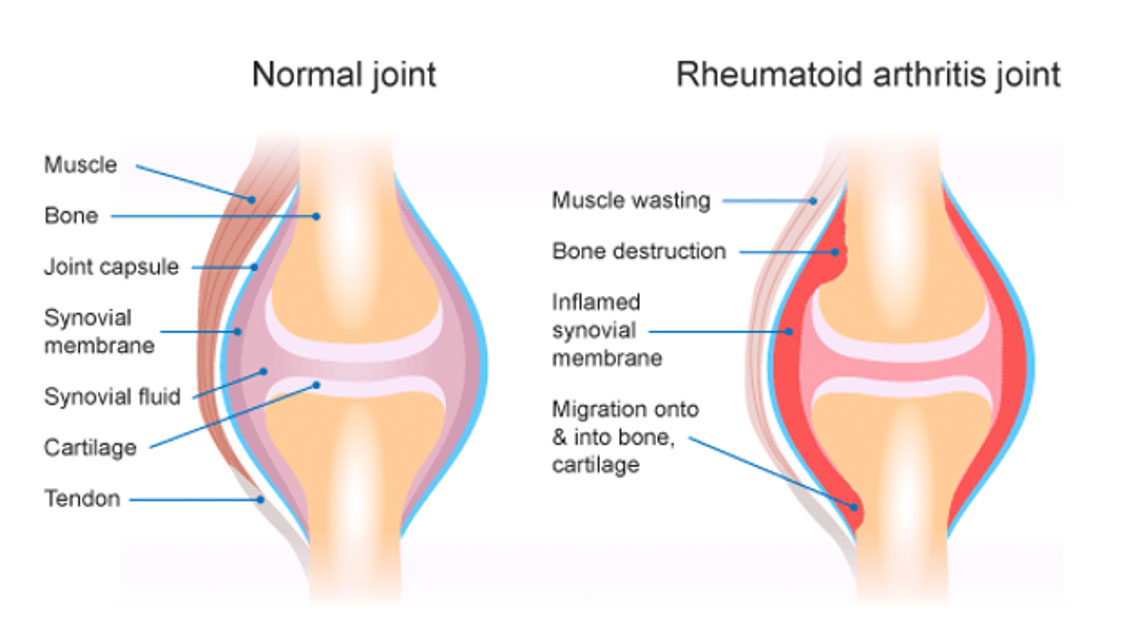Written by: Sonja Cornes (Accredited Exercise Physiologist)
What is it Rheumatoid Arthritis?

Rheumatoid Arthritis (RA) is a chronic, autoimmune inflammatory disease that affects the lining of the joints. The smaller joints on both sides of your hands and feet are usually affected first. As seen in Figure 1, compared to a healthy joint, the synovial membrane that surrounds the joint becomes inflamed and can lead to changes of structures in and around the joint.
Patients’ report symptoms such as – pain, swelling, stiffness, and fatigue. These symptoms can impact a person’s quality of life, physical function, mental wellbeing, and ability engage in the community.

Figure 1. Comparison between a healthy joint and a joint with Rheumatoid arthritis.
Prevalence of Rheumatoid Arthritis in Australia
In Australia approximately 456,000 or 1.9% of the population are diagnosed with RA. The rate of diagnosis is slightly higher for women (2.3%) compared to men (1.5%) (AIHW, 2020).
Risk Factors for Other Conditions
Due to the inflammatory nature of the Rheumatoid Arthritis, patients can have an increased risk of other complications such as:
- Increased risk of cardiovascular disease
- Rheumatoid cachexia which is where a person develops an increase in fat mass and reduce muscle mass. This can lead to an increase in the risk of developing diabetes, hypertension, and other metabolic diseases.
How can exercise help Rheumatoid Arthritis?
A key concern that has been identified in person’s with RA, is fear of causing damage to the joint or triggering a flare up when engaging in exercise. It’s important to know that exercise is safe and beneficial for person’s with this condition.
Recent evidence has shown that engaging in aerobic and strengthening exercise can help manage symptoms and improve a person’s capacity to complete daily activities. Some of the key benefits found in recent literature is detailed below:
- Exercise can significantly improve fitness and strength. This means we can do more with less effort.
- Exercise can reduce the risk of developing cardiovascular disease and improve the health of your heart.
- Exercise can significantly improve functional ability. For example it can improve your ability to rise out of a chair and complete your day to day activities.
- Exercise can reduce fatigue.
- Exercise can elicit beneficial changes to body composition i.e. increase muscle mass, and reduce fat mass.
- Exercise can boost your mood!
How can an Exercise Physiologists help?
Accredited Exercise Physiologists (AEP) form an important part of a multidisciplinary team. They will collaborate with other health professionals such as general practitioners, rheumatologists and physiotherapists to provide persons living with RA the best possible care is and advice to improve their health and wellbeing.
AEPs are university trained health professionals who specialise in using exercise to treat, manage and or prevent a number of conditions including RA.
An AEP will work with you to create an individualised exercise program that reflects your preferences, needs, and goals and can modify activities during flare ups.
Key Take Aways
Exercise plays an integral role in helping to manage Rheumatoid Arthritis. An Accredited Exercise Physiologist can work with you and your health care team to create a treatment plan specific to you. For more information come and have a chat today with one of our AEPs.
References
Hurkmans, E., van der Giesen, F. J., Vlieland, T. P. V., Schoones, J., & Van den Ende, E. C. (2009). Dynamic exercise programs (aerobic capacity and/or muscle strength training) in patients with rheumatoid arthritis. Cochrane Database of Systematic Reviews, (4).
Metsios, G. S., & Kitas, G. D. (2018). Physical activity, exercise and rheumatoid arthritis: effectiveness, mechanisms and implementation. Best Practice & Research Clinical Rheumatology, 32(5), 669-682.
Osthoff, A. K. R., Niedermann, K., Braun, J., Adams, J., Brodin, N., Dagfinrud, H., … & Vlieland, T. P. V. (2018). 2018 EULAR recommendations for physical activity in people with inflammatory arthritis and osteoarthritis. Annals of the rheumatic diseases, 77(9), 1251-1260.
Sveaas, S. H., Smedslund, G., Hagen, K. B., & Dagfinrud, H. (2017). Effect of cardiorespiratory and strength exercises on disease activity in patients with inflammatory rheumatic diseases: a systematic review and meta-analysis. British journal of sports medicine, 51(14), 1065-1072.
aihw.gov.au/reports/chronic-musculoskeletal-conditions/rheumatoid-arthritis/contents/what-is-rheumatoid-arthritis
